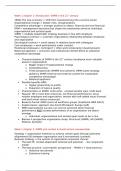Week 1 chapter 1: Introduction: SHRM in the 21 st century
1990s The new economy = shift from manufacturing into a service sector
Organizational change = Global crisis, reorganizations
Competitive advantage = stronger position to others, financial and non-financial
HRM = management decisions that shape the relationship aimed at individual,
organizational and societal goals
SHRM = multiple stakeholder strategy business in line with employee
Psychological contract = unwritten expectations relationship between employee
and organization
Sociological contract = social aspect in relations bond with colleagues
Core employees = work permanently under contract
Peripheral employees / contingent = often work temporarily (cleaning team)
Balanced approach = economic and institutional interest blend to sustained
competitive advantage
Characterizations of SHRM in the 21st century (employee most valuable
assets in organization)
o Bigger impact of organizational change
o Competitiveness
o Three perspectives (MHRM (recruitment), IHRM (same strategy
global) & SHRM (internal and external context for sustainable
competitive advantage)
o Balanced approach
Possible benefits HRM
o Higher productivity & profits
o Expansion of sales & quality
Characteristics in SHRM: multi-actor, a broad societal view, multi-level
Paauwe: HR is more than resources, not financial performance, focus
relation employee and organization, tension with soft added value (human)
and hard moral values (resources)
Boxall & Purcell: HRM covers all workforce groups (traditional HRM didn’t)
Angelo-Saxon; approach Usa (hard) Rhineland: Europa (soft)
SBM organizational success can only be achieved when financial
performance AND societal performance of an organization are above
average
o individual, organizational and societal goal needs to be in line
Bolman 4 perspective organization study: Structural (SHRM), HR (SHRM),
Political, Symbolic
Week 1 chapter 2; SHRM and context & Guest lecture Leeuwendaal
Strategy = organization intention to achieve certain goals through plannend
allignement (fit) between organization and it environment (context).
Business strategy = the system of organization important choices
The best fit: context-dependent (internal and external) - Six component
model
The best practice: universalistic perspective - Pfeffer’s 7 best practices
o Selective recruitment
o Extensive training
, o Performance-related pay
o Teamworking
o Information sharing and communication
o Reduction of status differences
o Employment security
Goals in strategy can be narrow (sales,profits) or broad (organization,
societal, individual)
Strategy scan – better fit in environment (context) = better performance
Environment -> the strategy (purpose, mission, vision) -> HRM
Business strategy concist of Competitive-,financial, operation, HR strategy
Fits SHRM:
o Strategic/vertical fit = alignment of business- and HR strategy
(administrative linkage, one-way linkage, two-way linkage,
integrative linkage (seat on table)
o Internal/horizontal fit = alignment individual HR practices (HR
system are practice combined for best results) (deadly combination)
o Organizational fit = HR fit with other systems
o Environmental/institutional fit = HR fit with Market & Institutional
(coercive, normative, mimetic)
Stategic choice perspective: Hyper determinism (no leeway) & hyper
voluntarism (internal choice)
A talent is a natural pattern By investing in it, it becomes a strength.
Leeuwendaal focus: Strengts, engagement, performance
Talent clue: Desire, Learning quick, Flow, Excellence, Satisfaction
(Strategy = 5 years from now (long term) Tactical = 1 year from now (short
term)
, Week 2 chapter 3: HRM and performance: adding value through people
Sustained competive advantage = long term organizational success by unique
resources and qualities
Ultimate business goals (UBG) = organizational targets aimed at creating validity
with adequate returns (1) and sustained competive advantage (2)
Employability paradox = invest in employers, commitment will increase and
turnover rate will decrease
Outside in to the inside-out approach
o Reverse approach HR value chain: UBG -> Critical success factors -
> employee attitudes and behaviours -> Hr practices
Internal resources can be financial, physical, organizational and HR
Substained competive advantage by internal resources that are:
o valuable
o Rare
o Inimitable
o Non-substitutable
Difficult to imitate because
o Path dependency
o Causal ambiguity
o Social complexity
Boxall -> competitive
advantage = UBG +
Organizational performance
(critical HR and non-critical
Is a resource...
HR Goals) Disavantage: focus on
profit
Critical HR Goals desired types
o Labor productivity (cost-
effectiveness)
o Organizational flexibility
(numerical, functional, mental)
o Social legitimacy and
employment citizenship
(legitimacy of organization)
Critical Goals to HR outcomes
o Distal & Proximal outcomes
(directly affected by HR)
Hr practices are not direct related to
firm performance
Hr Practices: Intended (HR-professional), Actual (line managers), Perceived
(employee) (influence outcome).
People are the organisation. Work ability <-> employability = + more
career success
Working with people and pay attention. HRM is outdated -> people are not
resources






